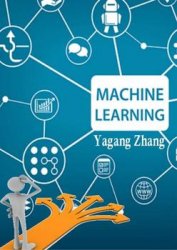Machine Learning (2017)
- Добавил: literator
- Дата: 8-12-2017, 17:12
- Комментариев: 0
 Название: Machine Learning
Название: Machine Learning Автор: Yagang Zhang
Издательство: ITexLi
ISBN: 953-307-033-1
Год: 2017
Страниц: 446
Язык: английский
Формат: pdf
Размер: 16.7 MB
The goal of this book is to present the key algorithms, theory and applications that from the core of machine learning. Learning is a fundamental activity. It is the process of constructing a model from complex world. And it is also the prerequisite for the performance of any new activity and, later, for the improvement in this performance. Machine learning is concerned with constructing computer programs that automatically improve with experience. It draws on concepts and results from many fields, including artificial intelligence, statistics, control theory, cognitive science, information theory, etc. The field of machine learning is developing rapidly both in theory and applications in recent years, and machine learning has been applied to successfully solve a lot of real-world problems.
This book presents today’s state and development tendencies of machine learning. The book is intended for both graduate and postgraduate students in fields such as computer science, cybernetics, system sciences, engineering, statistics, and social sciences, and as a reference for software professionals and practitioners. The book will be of interest to industrial engineers and scientists as well as academics who wish to pursue machine learning.
Machine learning techniques have the potential of alleviating the complexity of knowledge acquisition.
Taking into account the large amount of knowledge about machine learning and practice presented in the book, it is divided into three major parts: Introduction, Machine Learning Theory and Applications.
Part I focuses on the introduction to machine learning. The author also attempts to promote a new design of thinking machines and development philosophy. Considering the growing complexity and serious difficulties of information processing in machine learning, in Part II of the book, the theoretical foundations of machine learning are considered, and they mainly include self-organizing maps (SOMs), clustering, artificial neural networks, nonlinear control, fuzzy system and knowledge-based system (KBS).
Part III contains selected applications of various machine learning approaches, from flight delays, network intrusion, immune system, ship design to CT and RNA target prediction.
Contents:
Preface
1 Machine Learning: When and Where the Horses Went Astray?
2 SOMs for Machine Learning
3 Relational Analysis for Clustering Consensus
4 A Classifier Fusion System with Verification Module for Improving Recognition Reliability
5 Watermarking Representation for Adaptive Image Classification with Radial Basis Function Network
6 Recent Advances in Neural Networks Structural Risk Minimization Based on Multiobjective Complexity Control Algorithms
7 Statistics Character and Complexity in Nonlinear Systems
8 Adaptive Basis Function Construction: An Approach for Adaptive Building of Sparse Polynomial Regression Models
9 On The Combination of Feature and Instance Selection
10 Fuzzy System with Positive and Negative Rules
11 Automatic Construction of Knowledge-Based System Using Knowware System
12 Applying Fuzzy Bayesian Maximum Entropy to Extrapolating Deterioration in Repairable Systems
13 Alarming Large Scale of Flight Delays: an Application of Machine Learning
14 Machine Learning Tools for Geomorphic Mapping of Planetary Surfaces
15 Network Intrusion Detection using Machine Learning and Voting techniques
16 Artificial Immune Network: Classification on Heterogeneous Data
17 Modified Cascade Correlation Neural Network and its Applications to Multidisciplinary Analysis Design and Optimization in Ship Design
18 Massive-Training Artificial Neural Networks (MTANN) in Computer-Aided Detection of Colorectal Polyps and Lung Nodules in CT
19 Automated Detection and Analysis of Particle Beams in Laser-Plasman Accelerator Simulations
20 Specificity Enhancement in microRNA Target Prediction through Knowledge Discovery
21 Extraction Of Meaningful Rules In A Medical Database
22 Establishing and Retrieving Domain Knowledge from Semi-Structural Corpora
Скачать Machine Learning
[related-news] [/related-news]
Внимание
Уважаемый посетитель, Вы зашли на сайт как незарегистрированный пользователь.
Мы рекомендуем Вам зарегистрироваться либо войти на сайт под своим именем.
Уважаемый посетитель, Вы зашли на сайт как незарегистрированный пользователь.
Мы рекомендуем Вам зарегистрироваться либо войти на сайт под своим именем.
